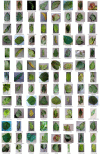An Industrial-Grade Solution for Crop Disease Image Detection Tasks
- PMID: 35832228
- PMCID: PMC9272756
- DOI: 10.3389/fpls.2022.921057
An Industrial-Grade Solution for Crop Disease Image Detection Tasks
Abstract
Crop leaf diseases can reflect the current health status of the crop, and the rapid and automatic detection of field diseases has become one of the difficulties in the process of industrialization of agriculture. In the widespread application of various machine learning techniques, recognition time consumption and accuracy remain the main challenges in moving agriculture toward industrialization. This article proposes a novel network architecture called YOLO V5-CAcT to identify crop diseases. The fast and efficient lightweight YOLO V5 is chosen as the base network. Repeated Augmentation, FocalLoss, and SmoothBCE strategies improve the model robustness and combat the positive and negative sample ratio imbalance problem. Early Stopping is used to improve the convergence of the model. We use two technical routes of model pruning, knowledge distillation and memory activation parameter compression ActNN for model training and identification under different hardware conditions. Finally, we use simplified operators with INT8 quantization for further optimization and deployment in the deep learning inference platform NCNN to form an industrial-grade solution. In addition, some samples from the Plant Village and AI Challenger datasets were applied to build our dataset. The average recognition accuracy of 94.24% was achieved in images of 59 crop disease categories for 10 crop species, with an average inference time of 1.563 ms per sample and model size of only 2 MB, reducing the model size by 88% and the inference time by 72% compared with the original model, with significant performance advantages. Therefore, this study can provide a solid theoretical basis for solving the common problems in current agricultural disease image detection. At the same time, the advantages in terms of accuracy and computational cost can meet the needs of agricultural industrialization.
Keywords: activate quantitative; convolutional neural network; crop disease detection; knowledge distillation; model compression; model deployment.
Copyright © 2022 Dai and Fan.
Conflict of interest statement
The authors declare that the research was conducted in the absence of any commercial or financial relationships that could be construed as a potential conflict of interest.
Figures















References
-
- Al-Wesabi F. N., Albraikan A. A., Hilal A. M., Eltahir M. M., Hamza M. A., Zamani A. S. (2022). Artificial intelligence enabled apple leaf disease classification for precision agriculture. Comput. Mat. Contin. 70, 6223–6238. 10.32604/cmc.2022.021299 - DOI
-
- Bakurov I., Buzzelli M., Schettini R., Castelli M., Vanneschi L. (2022). Structural similarity index (SSIM) revisited: a data-driven approach. Expert Syst. Appl. 189, 116087. 10.1016/j.eswa.2021.116087 - DOI
-
- Bochkovskiy A., Wang C.-Y., Liao H.-Y. M. (2020). YOLOv4: optimal speed and accuracy of object detection. ArXiv:200410934 [Cs, Eess]. 10.48550/arXiv.2004.10934 - DOI
-
- Chakrabarti A., Moseley B. (2019). Backprop with approximate activations for memory-efficient network training, in Advances in Neural Information Processing Systems, Vol. 32 (Curran Associates Inc). Available online at: https://proceedings.neurips.cc/paper/2019/hash/30c8e1ca872524fbf7ea5c519...
LinkOut - more resources
Full Text Sources
Miscellaneous

